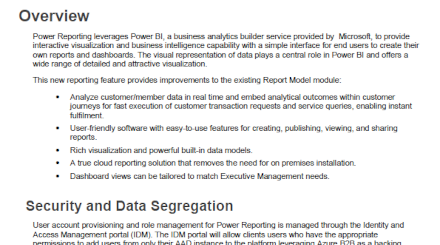Power BI Integration
Project: New feature documentation that uses Microsoft Power BI and existing core data to allow clients to create customized visial reporting.
Context: Feature writer, working with the extended stakeholders to ensure a smooth roll out, based on the concern that clients must learn Microsoft Power BI in addition to the customized Power Reporting front-end UI. In addition to the materials provided by Sales, client were provided with:
- online release notes (below)
- Power Reporting User Guide
Achievements:
- Implementations and end-users were successfully able to install, setup, and use the new feature.
Power Reporting Release Notes
Note: Power Reporting is a separately licensed enhancement that requires setup by Finastra. Please contact you Account Executive for more information. Power Reporting leverages Power BI, a business analytics builder service provided by Microsoft, to provide interactive visualization and business intelligence capability with a simple interface for end users to create their own reports and dashboards. The visual representation of data plays a central role in Power BI and offers a wide range of detailed and attractive visualization. This new reporting feature provides improvements to the existing Report Model module:
- Analyze customer/member data in real time and embed analytical outcomes within customer journeys for fast execution of customer transaction requests and service queries, enabling instant fulfilment.
- User-friendly software with easy-to-use features for creating, publishing, viewing, and sharing reports.
- Rich visualization and powerful built-in data models.
- A true cloud reporting solution that removes the need for on premises installation.
- Dashboard views can be tailored to match Executive Management needs.
Resources
- Download the Power Reporting Fact Sheet to learn more about Power Reporting’s features and benefits.
- Go to the Power Reporting Preview Video to get a sneak peek of this enhancement.
- To get a list of System Requirements and Prerequisites, go to the Power Reporting User Guide.
- Download the spreadsheet attached to Power Reporting Dictionary for a complete list of fields that can be leveraged in Power Reporting.
